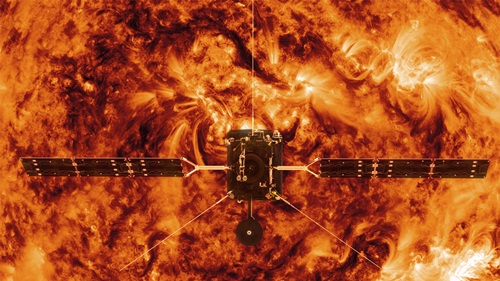The European Space Agency (ESA) on Tuesday carried out final simulations of the Solar Orbiter at the agencies control team, before the Sun-seeking spacecraft lifts off for real on 6 February.
After months of nerve-wracking simulation training, which has seen the control team play out a range of scenarios where something goes wrong, mission control is almost “green for launch,” ESA stated in a release.
The Solar Orbiter, a joint programme of ESA and Nasa, will begin its loopy journey through space on the way to the Sun on 6 February.
The spacecraft will use a gravitational assists from Earth and Venus, and a series of chemical thruster burns to reach a unique high-inclination orbit that will allow it to take the first pictures of the Sun’s poles, ESA said.
Solar Orbiter will make one gravity assist flyby of Earth and numerous flybys of Venus over the course of its mission to adjust its orbit, bringing it closer to the Sun and also out of the plane of the Solar System to observe the Sun from progressively higher inclinations. This will result in the spacecraft being able to take the first ever images of the Sun’s polar regions, crucial for understanding how the Sun ‘works’.
Reaching this orbit, and safeguarding the spacecraft from the intense heat and radiation as it carries out its scientific mission, will require tricky operations back on Earth, it added.
To ensure Solar Orbiter’s safety as best they can, teams at ESA’s ESOC mission control on Tuesday carried out rehearsals of the launch and Early Orbit Phase (LEOP) of the craft’s mission, during which time the spacecraft ‘wakes up’ and solar panels and instrument booms are deployed, a critical and risky part of the mission.
For Solar Orbiter, during LEOP, the craft has to deploy a ‘boom’. Measuring 4.4 metres in length when fully extended, this tail-like extension carries four of Solar Orbiter’s scientific measuring instruments.
“The booms are deployed before all thrusters can be fired on the spacecraft, as some thrusters can potentially contaminate the instruments onboard,” explains Andrea Accomazzo, flight director for the mission.
LEOP simulations began on 10 September 2019 in which teams brainstormed boom deployment and other challenging events, such as a team member suddenly becoming sick or a computer crashing, to critical errors that threaten the safety of the mission, such as a failure to establish communication with the spacecraft or a problem deploying its solar panels.
The final two simulations will see the control team – split into two, to provide round-the clock operations during the high-stress early days of the mission – run through a ‘nominal’ launch and early orbit, in which everything goes to plan.
Finally, the dress rehearsal will take place on 31 January, during which time teams at mission control run through the launch sequence and test communication between mission control, the launch provider and of course, the satellite, just days before launch.
Solar Orbiter is a space mission of international collaboration between ESA and NASA. Its mission is to perform unprecedented close-up observations of the Sun and from high-latitudes, providing the first images of the uncharted polar regions of the Sun, and investigating the Sun-Earth connection. It is scheduled to launch from Cape Canaveral in February 2020.








.webp)














